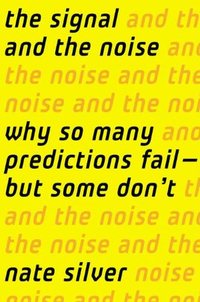

Purchase
The Signal And The Noise
Nate Silver
Why Most Predictions Fail But Some Don't
Penguin Press
October 2012
On Sale: September 27, 2012
545 pages
ISBN: 159420411X
EAN: 9781594204111
Kindle: B007V65R54
Hardcover / e-Book
Add to Wish List
Non-Fiction
Nate Silver built an innovative system for predicting
baseball performance, predicted the 2008 election within a
hair’s breadth, and became a national sensation as a
blogger—all by the time he was thirty. The New York
Times now publishes FiveThirtyEight.com, where
Silver is one of the nation’s most influential political
forecasters.
Drawing on his own groundbreaking work,
Silver examines the world of prediction, investigating how
we can distinguish a true signal from a universe of noisy
data. Most predictions fail, often at great cost to society,
because most of us have a poor understanding of probability
and uncertainty. Both experts and laypeople mistake more
confident predictions for more accurate ones. But
overconfidence is often the reason for failure. If our
appreciation of uncertainty improves, our predictions can
get better too. This is the “prediction paradox”: The more
humility we have about our ability to make predictions, the
more successful we can be in planning for the
future.
In keeping with his own aim to seek truth
from data, Silver visits the most successful forecasters in
a range of areas, from hurricanes to baseball, from the
poker table to the stock market, from Capitol Hill to the
NBA. He explains and evaluates how these forecasters think
and what bonds they share. What lies behind their success?
Are they good—or just lucky? What patterns have they
unraveled? And are their forecasts really right? He explores
unanticipated commonalities and exposes unexpected
juxtapositions. And sometimes, it is not so much how good a
prediction is in an absolute sense that matters but how good
it is relative to the competition. In other cases,
prediction is still a very rudimentary—and
dangerous—science.
Silver observes that the most
accurate forecasters tend to have a superior command of
probability, and they tend to be both humble and
hardworking. They distinguish the predictable from the
unpredictable, and they notice a thousand little details
that lead them closer to the truth. Because of their
appreciation of probability, they can distinguish the signal
from the noise.
With everything from the health of
the global economy to our ability to fight terrorism
dependent on the quality of our predictions, Nate Silver’s
insights are an essential read.
Comments
No comments posted.
Registered users may leave comments.
Log in or register now!
| 


 © 2003-2025 off-the-edge.net
all rights reserved Privacy Policy
© 2003-2025 off-the-edge.net
all rights reserved Privacy Policy